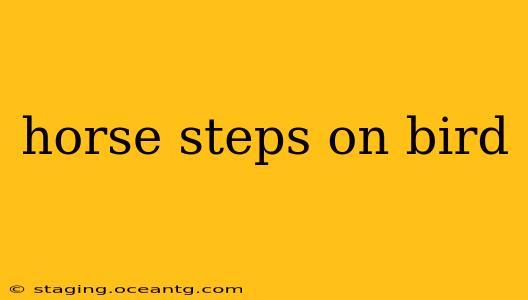The image of a horse accidentally stepping on a bird is jarring. While seemingly a rare event, it's a scenario that highlights the potential dangers of shared environments between large and small animals. Understanding the impact of such an incident, the likelihood of it happening, and how to prevent it are crucial for both animal welfare and responsible land management.
What Happens When a Horse Steps on a Bird?
The outcome of a horse stepping on a bird depends heavily on several factors: the size and type of bird, the weight and force of the horse's step, and where the bird is struck. A small bird is far more likely to be fatally injured or killed outright than a larger, more robust bird. The force of the impact can cause internal injuries, broken bones, and potentially death. Even if the bird survives the initial impact, it might suffer from long-term injuries that impair its ability to fly, forage, or evade predators.
How Likely is it for a Horse to Step on a Bird?
The probability of a horse stepping on a bird is relatively low, but not impossible. It's more likely to occur in areas with high bird populations and where horses are allowed to roam freely, particularly in pastures with dense vegetation that might obscure the birds' presence. Horses aren't inherently malicious; it's usually accidental. Factors such as the horse's temperament (some are more careful than others), the terrain, and the bird's behavior all play a role.
What Can Be Done to Prevent a Horse from Stepping on a Bird?
Preventing such accidents requires a proactive approach focusing on both the horse's environment and behavior:
- Maintaining Pasture Hygiene: Keeping pastures clean and free of excessive debris can reduce bird nesting sites in areas where horses frequently graze. Regular mowing can also improve visibility.
- Careful Pasture Management: Rotating grazing areas can help minimize the concentration of birds in any one location.
- Training and Handling: While horses can't be trained to actively avoid birds, careful handling and training can encourage more mindful movement, especially in areas known for bird activity.
- Monitoring Horse Behavior: Regularly observing horses' movements in the pasture can help identify potential hazards. Any changes in behavior should be noted and addressed.
- Providing Alternative Feeding Locations: If birds are attracted to food sources near where horses are feeding, relocating the feed troughs might help minimize the risk of interaction.
Are There Specific Bird Species More at Risk?
Smaller ground-dwelling birds are undoubtedly more vulnerable. Think of species like sparrows, wrens, or smaller songbirds that might nest low to the ground or forage in open areas frequented by horses. Larger birds, those that fly higher or are less likely to be in the path of a horse, have a lower risk.
What Should I Do If I Witness a Horse Stepping on a Bird?
If you witness such an incident, assess the bird's condition. If the bird is clearly injured or dead, the most humane course of action may be to contact your local animal control or wildlife rehabilitation center. They are best equipped to handle the situation appropriately.
Can Horses Sense Birds?
While horses don't have the same visual acuity as humans, they possess excellent hearing and a keen sense of smell. They might be able to detect the presence of birds through these senses, but this doesn't guarantee they will avoid stepping on them, especially if the bird is hidden or the horse is not paying close attention.
This article provides a comprehensive overview of the issue. Remember, responsible land management and proactive measures significantly reduce the likelihood of such unfortunate incidents occurring. Always prioritize the welfare of both horses and birds within shared environments.
